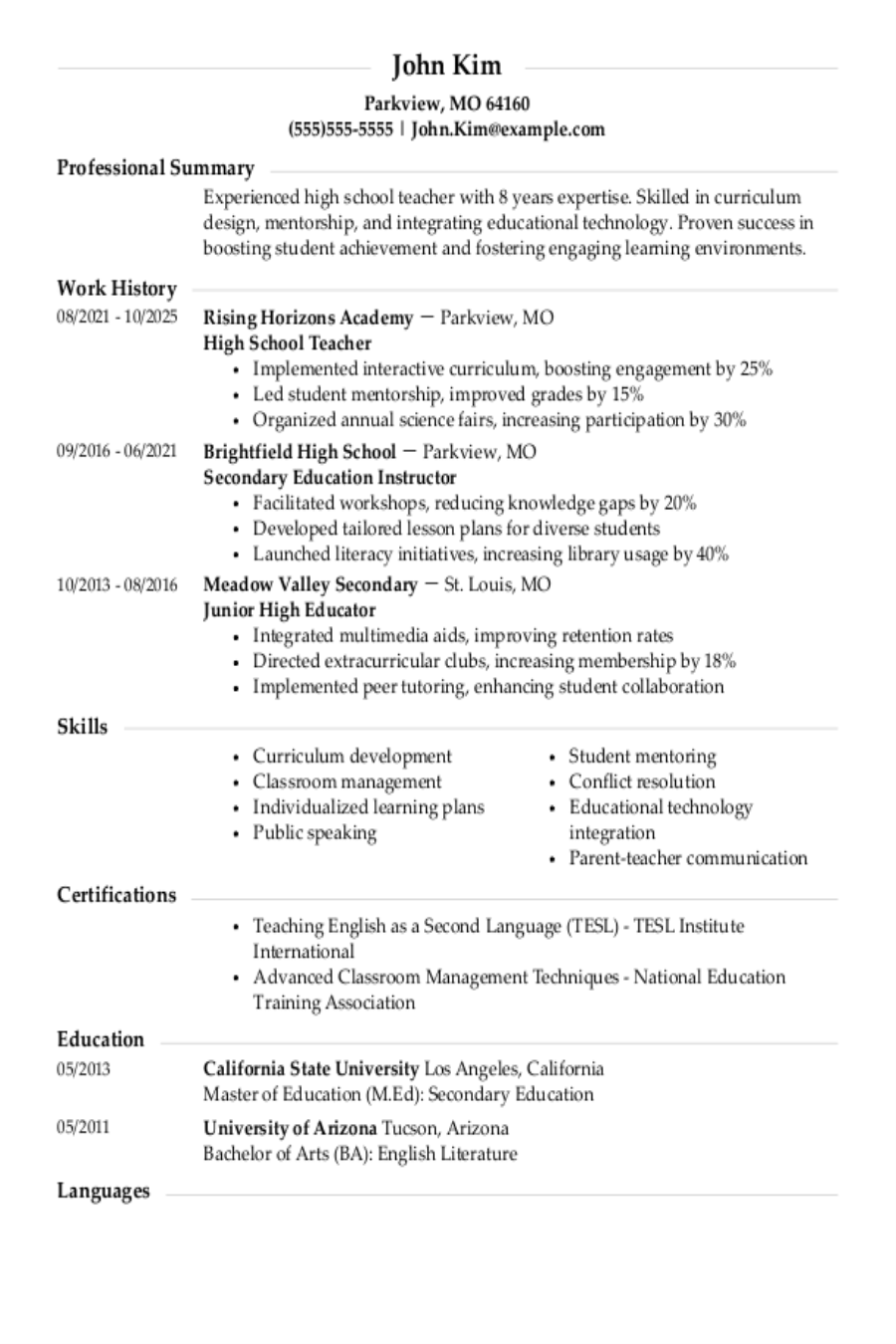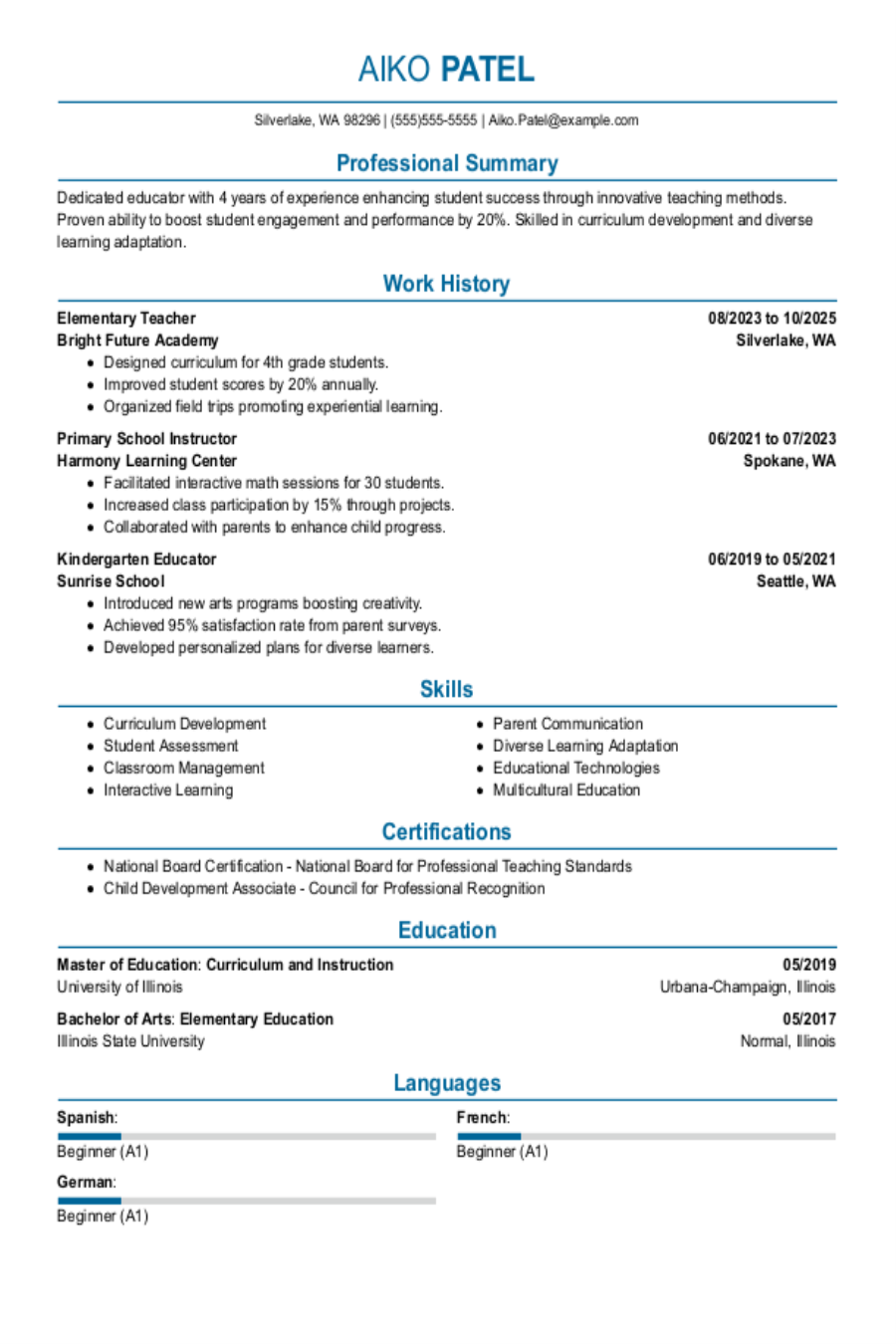When it comes to writing a resume that gets attention, showing promotions can make a significant difference.
Why? Employers are always on the lookout for candidates who have proven themselves by advancing within an organization. When you put a promotion on your resume, you show how your skills and experience have developed over time, underscoring your value as an employee.
So how do you go about this? We're here to help!
In this guide, you'll find:
- Tips on how to show a promotion effectively on a resume.
- Different methods for listing multiple positions at the same company.
- Example resume sections that demonstrate how to highlight career progression.
- Key tips for avoiding common mistakes when listing promotions.
- Advice on choosing the best format to showcase your career growth.
Ready to show your promotions and make an amazing resume? Try our easy-to-use AI Resume Builder, where you can upload your existing resume or start fresh and answer simple prompts to get instant, customizable content suggestions to highlight your career growth in no time.
How to Show a Promotion on a Resume
You may know how to write a resume, but did you know there are several effective strategies for listing promotions? The method you choose depends on the nature of the promotion and how you want to highlight your career growth.
Below are a few common approaches to help you decide how to show promotion on a resume and how to list it effectively.
Method 1: Separate entries for each role
If your promotion involved a significant shift in responsibilities or a new job title, the best approach is to create a separate entry for each position within the same company.
This method allows you to fully showcase the accomplishments and responsibilities associated with each role and is a great way to show promotion on a resume.
Example:
Fake Industries, Inc. – Buffalo, NY
Senior Marketing Manager (June 2021 – Present)
- Lead a team of 12 marketing professionals, increasing overall campaign performance by 25%.
- Implemented a new digital marketing strategy that boosted lead generation by 40%.
- …
Fake Industries, Inc. – Buffalo, NY
Marketing Manager (January 2018 – June 2021)
- Managed all marketing campaigns and partnerships, resulting in a 15% increase in brand awareness.
- Spearheaded the redesign of the company's website, improving user engagement by 20%.
- …
By using separate entries, you highlight each role individually and make it clear to the employer that you've been promoted within the same organization.
If you need to save space on your resume, especially to keep it to one page, write the name and location of the employer only once. Then, list all promotions underneath with separate entries for each job title.
Method 2: Single entry with multiple titles
If your promotion occurred within the same department and your duties remained somewhat consistent, you may prefer to use a single entry with multiple job titles.
This method keeps your resume concise and demonstrates that you've been promoted without overloading your work history section.
Example:
Money Is Our Priority Corp. – Chicago, IL
Project Manager (March 2019 – Present)
Assistant Project Manager (July 2016 – March 2019)
- Promoted after consistently delivering projects on time and under budget.
- Manage a portfolio of 15+ projects, leading cross-functional teams and ensuring timely execution.
- Reduced project turnaround time by 10% after implementing new tracking software.
This approach makes it easy to see that you've advanced in your career within the same company, while keeping your resume streamlined. Since you avoid repeating yourself, it is a good option for roles where promotions build upon your existing skills and responsibilities.
Method 3: Highlight promotions in the work experience description
If your promotion didn't involve a formal title change but came with new responsibilities, you can highlight your growth within the work experience description itself.
This method will allow you to show how your role evolved without needing a new job title in the work history section of your resume.
Example:
Digital Bagels – Austin, TX
Software Engineer (May 2017 – Present)
- Promoted to lead developer for the company's flagship software, overseeing a team of five engineers.
- Played a critical role in designing and launching two major software updates, increasing user satisfaction by 30%.
- Enhanced system performance, reducing downtime by 15%.
By detailing the promotion within the job description, you show your growth without needing a separate job title.
Which method do employers prefer?
There's no universal preference when it comes to listing promotions on a resume.
Employers value clarity and context, so the best method depends on how significant the change in responsibilities was. Consider:
- If your promotion brought new challenges and accomplishments, separate entries might make the impact clearer.
- For roles with steady growth, a single entry with multiple titles or bullet points clarifying your promotion could be more efficient.
Choose the method that best highlights your career progression and keeps the layout of your resume readable.
How to Show Multiple Positions at the Same Company
It's possible you might have held multiple positions within the same company. This makes it even more important to clearly show how your role has evolved over time.
Not only will it highlight your loyalty and growth within the organization but it will also demonstrate how your skills and responsibilities have expanded.
Consider the first two methods for listing a promotion on a resume that were detailed above. These offer helpful options for showing multiple positions at the same company.
List multiple positions as separate entries
This method involves listing each position separately under the same company name in reverse-chronological order.
Just like above, it's ideal when your roles significantly differ in responsibilities or achievements. This format gives each position the spotlight, ensuring that your progression is clear to the employer.
Example:
Tech Jargon Consultants – Denver, CO
Senior Sales Manager (April 2021 – Present)
- Manage a team of 20 sales professionals, increasing quarterly revenue by 15%.
- Developed training programs that improved team performance by 20%.
- …
Sales Manager (January 2018 – April 2021)
- Supervised 10 sales associates, leading to a 12% increase in customer satisfaction.
- Introduced a new customer relationship management system that boosted efficiency by 10%.
- …
Sales Associate (August 2015 – January 2018)
- Ranked in the top 5% of sales associates companywide for three consecutive quarters.
- Generated $500K in revenue in 2017, exceeding personal sales targets by 30%.
- …
By listing each position in chronological order, you demonstrate a clear pattern of career advancement and how your responsibilities have grown with each role.
Group multiple positions under one heading
If your roles within the company were similar or if you want to keep your resume concise, you can group all your positions under a single company heading. It's a great way to show that you've held multiple positions within the same company while keeping your resume format streamlined.
Example:
LMN Corporation – Chicago, IL
Senior Sales Manager (April 2021 – Present)
Sales Manager (January 2018 – April 2021)
Sales Associate (August 2015 – January 2018)
- Promoted to senior sales manager after consistently exceeding sales targets and driving team performance.
- Increased team efficiency by implementing new sales training programs that led to a 15% revenue increase.
- As a sales associate, ranked in the top 5% of all associates for sales performance.
- …
Why Show Promotions on Your Resume?
Promotions are a clear indicator of a positive career trajectory. When you show promotions on your resume, you're letting potential employers know that you've earned recognition and trust within your previous or current roles.
This reflects qualities like reliability, leadership, a strong work ethic, the ability to achieve results and to take on more responsibilities, which is exactly what employers want to see.
By listing promotions, you can demonstrate how your hard work led to growth, whether that means moving up the ranks or taking on complex projects.
Promotions also tell a story of your career progression, which can help explain gaps, transitions or shifts in responsibility. Knowing how to show promotion on a resume effectively can make the difference between blending in with other candidates and standing out as someone who has proven success in their career.
Key Tips for Showing Promotions on a Resume
Consider the following tips when adding a promotion to your resume to keep it as clear as possible for the hiring manager and applicant tracking system (ATS).
Key tips for showing promotions on a resume
- Use measurable achievements
Include specific, quantifiable results to demonstrate how your performance contributed to the company's success. Metrics like revenue growth or efficiency improvements show why you were promoted. - Highlight leadership roles and new skills
Emphasize new responsibilities or skills gained after your promotion to show professional growth. This gives employers insight into how your role evolved. - Maintain consistent formatting
Ensure consistent formatting for job titles, dates and bullet points across your resume. This keeps your resume polished and easy to read. - Tailor the format to the role
Choose the format that best reflects the responsibilities of each promotion — separate entries for distinct roles or a single entry for related positions. This helps showcase your advancement clearly. - Showcase team leadership and collaboration
If your promotion involved managing or leading teams, highlight this to showcase your leadership capabilities. Team success is a reflection of your ability to motivate and guide others. - Link promotions to company goals
Demonstrate how your promotions align with the company's broader objectives. This shows employers that you contributed to both your personal and the company's growth.
Also, avoid the following mistakes many people make when they want to show a promotion on a resume.
Common mistakes to avoid when listing promotions
- Underplaying the promotion
Don't hide your promotion — make it clear by listing it prominently with a summary of your achievements. Employers should instantly see your career progression. - Making it unclear to employers
Ensure promotions are easy to spot by clearly separating job titles and dates. Lack of clarity can confuse employers about your advancement. - Not including enough details
Avoid vague descriptions; be specific about the new responsibilities and achievements tied to your promotion. Details help emphasize your growth and accomplishments. - Inconsistent formatting
Use the same formatting throughout to make your resume professional and readable. Inconsistency can distract hiring managers from your key achievements.
Promotion on Resume Examples
It is probably clear by now that knowing how to put a promotion on a resume can make a significant difference in demonstrating your career growth.
Below are a few more examples of how to list them using the different methods discussed.
Example 1: Separate entries for each role
The Dorchester Clam Co. – Boston, MA
Senior Digital Marketing Manager (June 2020 – Present)
- Lead a team of 15 marketing specialists, increasing campaign ROI by 30%.
- Launched a new content strategy that boosted website traffic by 50%.
- …
Digital Marketing Manager (March 2017 – June 2020)
- Managed digital campaigns across multiple platforms, driving a 20% increase in brand awareness.
- Oversaw the redesign of the company's social media presence, increasing follower engagement by 25%.
- …
Example 2: Single entry with multiple titles
Blankets & Tea – San Francisco, CA
Product Manager (July 2020 – Present)
Assistant Product Manager (January 2018 – July 2020)
- Promoted to product manager after successfully launching three new product lines, increasing revenue by 40%.
- Led cross-functional teams and managed product life cycle from concept to launch, ensuring on time and under budget product delivery.
- …
Example 3: Highlighting promotion in the work experience description
Redundant Software – New York, NY
Software Developer (May 2016 – Present)
- Promoted to lead developer in 2019, overseeing a team of six engineers and leading the development of a key software update that increased user retention by 15%.
- Contributed to the design and implementation of three major software releases, which reduced customer complaints by 20%.
- …
These examples show how to add promotion on resume examples effectively, ensuring your career progression is clear to employers while highlighting key accomplishments.
Key Takeaways
Promotions demonstrate career growth
Listing promotions on your resume highlights your professional development, leadership abilities and dedication, making you stand out to employers.
Choose the right method to showcase promotions
Depending on the nature of the promotion, use separate entries, a single entry with multiple titles or highlight the promotion within job descriptions to clearly present your career progression.
Use measurable achievements
Back up your promotions with specific, quantifiable accomplishments to show employers the value you brought to each role.
Be consistent with formatting
Maintain uniformity in formatting for job titles, dates and bullet points to make your resume easy to read and professional.
Avoid common mistakes
Ensure your promotions are clear. Don't underplay their significance and avoid vague descriptions to effectively communicate your growth.
FAQ
If your job title stayed the same but your responsibilities increased, highlight the promotion in the job description. You can mention the promotion directly and describe how your role evolved, focusing on new duties and accomplishments.
If your promotions resulted in significant changes to your responsibilities or achievements, it's best to list each position separately. However, if the roles were closely related, grouping multiple titles under one company heading may be more effective and keep your resume concise.
The format depends on how distinct the roles were. Use separate entries for roles with different responsibilities or group titles under one company heading for more related positions to present a streamlined career progression.
If you've worked in different departments, list each position separately to highlight the distinct responsibilities and skills gained in each role. Make sure to clearly indicate the department changes to showcase your versatility and adaptability.
Yes, even if your promotion didn't involve a new title, you should still list the added responsibilities or leadership roles in your job description. Emphasize how your role expanded and the value you brought to the company through your growth.
Conor is a Certified Professional Resume Writer (CPRW) and member of the Professional Association of Resume Writers & Career Coaches dedicated to helping job seekers excel in their careers.
More resources

63% Expect AI’s Role in Compensation to Grow Significantly in the Next 5 Years
Resume Now s latest report examines how workers are responding...

How to Include Research Skills on a Resume: 40+ Examples
Check out our guide to understand what research skills are and...

How To Write a CV: The Ultimate Guide for 2025
Here is a complete and comprehensive guide to writing a CV ev...

High School Teacher Resume for 2025: Examples and Guide
Get inspired with our high school teacher professional resume ...

Elementary Teacher Resume: Examples, Templates & Tips for 2025
Conor McMahon CPRWCareer Writer Conor is a Certified Professi...

Assistant Professor Resume: Examples, Templates & Tips for 2025
Looking for a job as an assistant professor? Check out our tai...
